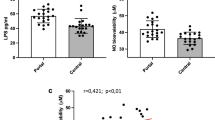Abstract
Under the hypothesis that portal endotoxemia, which has been considered evidence of endogenous endotoxemia, is actually a false-positive reaction of the Limulus test, the conventional method of determination, Toxicolor (TOX) and a new endotoxin-specific method, Endospecy (ES) were investigated, whereby portal endotoxemia was reexamined. Peripheral and portal blood samples were collected from 12 patients at various intervals during surgery for esophageal varices, and then evaluated by TOX and ES, the normal values of which are under 60.0 pg/ml and under 9.8 pg/ml, respectively. The mean peripheral and portal endotoxin (Et) levels by TOX were 23.1 pg/ml and 38.9 pg/ml, 1.5 h after the start of surgery, which continued to increase thereafter, the corresponding levels being 48.1 pg/ml and 58.7 pg/ml 8 h after the start of surgery, respectively. The portal Et levels were significantly higher by ES, indicating portal endotoxemia, the mean peripheral and portal Et levels being 6.9 pg/ml, and 6.5 pg/ml, 1.5 h after the start of surgery, these levels showing changes within a similar range. The levels determined by the conventional TOX method increased with time, to a portal Et level of 5.0 pg/ml 8 h after the start of surgery, whereas those determined by ES changed within the same range suggesting that the onset of portal endotoxemia primarily involves the G-factors and that endogenous endotoxemia does not occur.
Similar content being viewed by others
References
Triger DR, Boyer TD, Levin J (1978) Portal and systemic bacteraemia and endotoxemia in liver disease. Gut 19:935–939
Pritz H, Holst-Christensen J, Korner S (1976) Portal venous and systemic endotoxaemia in patient without liver disease and systemic endotoxaemia in patient with cirrhosis. Scand J Gastroenterol 11:857–863
Jacob AI, Goldberg PK, Bloom N, Degenshein GA (1977) Endotoxin and bacteria in portal blood. Gastroenterology 72:1268–1270
Olofsson P, Nylander G, Olsson P (1986) Endotoxin: routes of transport in experimental peritonistis. Am J Surg 151:443–446
Baker JW, Deitch EA, Berg RD, Specian RD (1988) Hemorrhagic shock induces bacterial translocation from the gut. J Trauma 28:896–906
Aoki K (1978) A study of endotoxemia in ulcerative colitis and Crohn's disease: II. Experimental study. Acta Med Okayama 32:207–216
Brearly S, Harris RI, Stone PGW, Keighley MRB (1985) Endotoxin levels in portal and systemic blood. Dig Surg 2:70–72
Deitch EA, Winterton J, Berg R (1987) The gut as a portal of entry bacteremia. Ann Surg 205:681–692
Hodler J, Cottier H (1992) Conventional supportive and possible future therapy in patients affected by GITS. Curr Stud Hematol Blood Transfus 59:241–300
Levin J, Bang FB (1968) Clottable protein in Limulus: Its localization and kinetics of its coagulation by endotoxin. Thromb Diath Haemorrh 19:186–197
Iwanaga S, Morita T, Harada T, Nakamura S, Niwa M, Takada K, Kimura T, Sakakibara S (1978) Chromogenic substrates for horseshoe crab clotting enzyme. Haemostasis 7:183–188
Kakinuma A, Asano T, Torii H, Sugino Y (1981) Gelation of Limulus amoebocyte lysate by an antitumor (1→3)-β-d-glucan. Biophys Res Commun 101:434–439
Morita T, Tanaka S, Nakamura T, Iwanaga S (1981) (1→3)-β-d-glucan mediated coagulation pathway found in limulus amebocyte lysate. FEBS Lett 129:318–321
Obayashi T, Tamura H, Tanaka S, Ohki M, Takahashi S, Arai M, Masuda M, Kawai T (1985) A new chromognic endotoxin-specific assay using recombined limulus coagulation enzyme and its clinical applications. Clin Chim Acta 149:55–65
Yajima M, Fukuda I, Otsuki K, Suzuki H, Mori K, Goto Y (1989) Non-septic endotoxemia in cirrhotic patients. Gastroenterol Jpn 24:262–269
Takahashi K (1988) Study on quantitative measurement of endotoxin in human blood using chromogenic substrate-especially pretreatment of plasma (in Japanese with English abstract). J Iwate Med Assoc 50:67–81
Inada K, Endo S, Takahashi K, Suzuki M, Narita T, Yoshida T, Suda H, Komuro T, Yoshida M (1991) Establishment of a new perchloric acid treatment method to allow determination of the total endotoxin content in human plasma by the limulus test and clinical application. Microbiol Immunol 35:303–314
Kikuchi M, Watanabe M, Sasaki A, Saitoh K, Inada K, Yoshida M (1989) Existence of glucan-like activity in the organs of rats. Causes of postoperative elevations of endotoxin using conventional limulus test (Toxicolor) (in Japanese). Nippon Geka Gakkai Zassi (J Jpn Surg Soc) 12:2052
Endo S, Matsuoka T, Amano K, Inoue Y, Hoshi S, Inada K, Suzuki M, Yoshida M (1989) Diagnosis of endotoxemia and fungemia by Endospecy test and Toxicolor test (in Japanese with English abstract). Kyuu Igaku 8:1015–1019
Kitamura M, Abo S, Hashimoto M, Izumi K, Kamiya A, Minamiya Y (1991) Study on endotoxin in patients who underwent surgery for esophageal cancer by analyzing portal vein blood obtain during operation (in Japanese with English abstract). Igakunoayumi 11:796–770
Author information
Authors and Affiliations
Rights and permissions
About this article
Cite this article
Kikuchi, M., Watanabe, M., Nakamura, R. et al. Portal and peripheral endotoxins in patients with esophageal varices undergoing surgery. Surg Today 25, 17–20 (1995). https://doi.org/10.1007/BF00309379
Received:
Accepted:
Issue Date:
DOI: https://doi.org/10.1007/BF00309379




